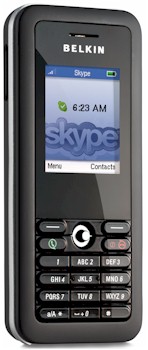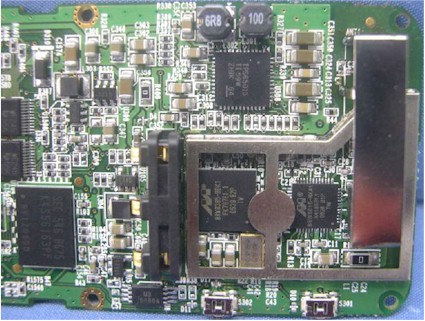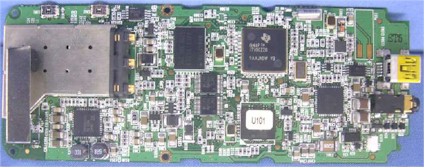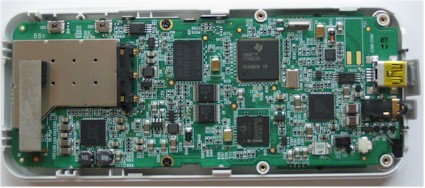Introduction, Specs and Design

| At a Glance | |
|---|---|
| Product | Belkin Wi-Fi Phone for Skype (F1PP000GN-SK) |
| Summary | Belkin version of Accton OEM’d phone with better battery life than SMC version |
| Pros | – Doesn’t need a computer running Skype – Much better battery life than SMC and Netgear phones – Intuitive, attractive interface – Good wireless range |
| Cons | • No Skype text chat • No browser-based authentication |
My previous reviews of SMC’s version of this phone OEM’d from Accton and Netgear’s version, whose maker I’m not sure of, have covered what these products have to offer pretty well. So this review will cover only the differences between Belkin’s and SMC’s version, which boil down to vastly improved battery life and features that work in Belkin’s version that didn’t work in SMC’s.
As the beauty shot above shows, Belkin’s phone is black to the SMC’s white. But what you can’t tell from the photo is that instead of a smooth plastic surface, the Belkin has a textured surface that I think is supposed to feel like a kidskin glove. The phone also has slightly softened edges that give it a nice feel in the hand. More importantly, however, is that the top surface of the phone is smooth, without the sharp recess that irritated me on SMC’s version.
Belkin includes a short USB cable and compact charger that accepts 100-240 VAC, 50/60 HZ. It also has a U.S.-style flat-blade plug that is not removable—just like SMC’s charger. Belkin doesn’t, however, throw in an earphone / mic, as SMC does, but joins SMC and Netgear in not including a protective case.
Note that the charging contacts on the bottom of the phone are located identically to those on the SMC phone. So you should be able to use the optional charging and charging / access point cradles announced by SMC last month—if you can find them.
Specs and Design Info
As mentioned earlier, both the Belkin and SMC phones are manufactured by SMC’s parent company Accton. The SMC phone I received was a pre-production unit and didn’t have an FCC ID label. But the Belkin phone did and the FCC ID confirmed its manufacture by Accton. I had to take the internal photos in the SMC article myself, but the Belkin’s FCC file came with internal photos…and a surprise!
Figure 1 shows the Belkin phone’s board, which you can compare to my photo of the SMC phone’s board in Figure 2. They look pretty identical to me!
Figure 1: Belkin phone board (click image to enlarge)
Figure 2: SMC phone board (click image to enlarge)
But the surprise comes in Figure 3, which is a close-up of the Belkin / SMC / Accton phone’s radio with its RF shield removed.

Figure 3: Belkin phone radio closeup
The shows that my guess was wrong about the phone using the Texas Instruments WL1251 WiLink 4.0 single-chip 802.11b/g radio that is used in the Netgear SPH101. Instead those are Marvell 88W8385 integrated 802.11g wireless MAC/BB and 88W8015 RF transceiver devices. Now I know why Marvell was showing the phone in its booth at the fall VON show a few months ago and demoing battery life!
Checking the specs in the User Guide, I found the same specs for transmit power (16 dBm [40 mW] for 802.11b / 12 dBm [16 mW], antenna gain (5.5 dBi), battery (removable Li-Ion 3.7 V minimum 1100 mAH) and Use Time: 3 hrs" / standby time of 50 hrs as the SMC product.
Finally, while browsing through the Settings > Information menu, I came upon the same "Powered by TrollTech.com" logo as in the SMC phone. I also recorded a V1.0.0.10 software version, 2006/09/13 software date and R03 hardware version.
In Use and Conclusion
Using the Belkin phone was more like using the Netgear SPH101 in that many of the bugs that I encountered in the SMC phone were fixed. It kept proper time, although it would show the 12:00AM time for a minute or so after power up. The proper Notifications area icons showed for missed calls and voicemail, and went away when I accessed the appropriate menu items.
In addition, the End / Power Down key worked as expected and holding the joystick in a direction kicked in a scroll function. And the black keys are much more readable than the white ones in both lighted and dark conditions. I also didn’t experience the ear-blastings I got from the SMC phone due to sluggish switching between ringing and normal listen volumes for the earpiece speaker that serves double duty.
Battery life, however, was the biggest surprise. After the short talk and standby times that I experienced with both the SMC and Netgear phones, I didn’t expect much different from the Belkin. But, boy, was I wrong! I performed two tests where I made a test call to a wireless notebook with a phone that had been charged overnight. Everything was in the same room and connected to a Linksys WRT54G wireless router. I left the connection open with the phone on my desk where it picked up mostly the sound of my typing and anything else within earshot. The two calls each lasted almost five hours (4 hr. 46 min. and 4 hr. 56 min.), which actually exceeds Belkin’s three hour spec!
Standby time was just as impressive. Again, starting with an overnight charge, I turned on the phone and just left it idle (but associated with my AP), with only one or two short (< 1 min.) calls during the test. Under these conditions, the phone stayed on just 15 minutes shy of 36 hours! As I write this, the phone is on a second trial and has lasted just about 24 hours so far, with the phone showing about 1/3 charge left. I should note that the phone flashed low battery warnings a few times during the trial, starting after the 24 hour mark, but kept going strong. Although the standby results are significantly lower than the 50 hour spec, it appears that someone has been working on power management and it is paying off!
What hasn’t changed, however, are the wireless connectivity oddities. The phone would emit the Skype sigh (or whatever that odd sound is) to indicate it had lost network connection within ten seconds of my unplugging the access point that it was connected to. But it didn’t give me the other sigh sound when it reconnected after I plugged the AP back in. The connection process also takes long enough to try your patience. It always first spends about ten seconds searching for open networks and if it finds only encrypted networks, asks for permission to connect then starts searching again.
Connecting to encrypted networks was a little flaky. The good news is that I was able to connect to a Linksys WRT54G access point using WEP 128 (I didn’t try 64 bit WEP) as well as WPA-PSK with both TKIP and AES encryption. The further good news is that the screen formatting problems I encountered with the security key-entering screens on the SMC phone have been solved.
But while it seemed like the phone would remember the different hex WEP key and WPA alphanumeric keyphrase, the phone seemed to be inconsistent in its operation. Sometimes, it would connect when I switched the access point mode from WEP to WPA, and sometimes it wouldn’t. And, of course, the phone always made me go through the entire search process each time instead of just getting on with it and connecting me.
One last security annoyance was that the phone doesn’t provide any information about the wireless security mode of the detected APs. I suppose this limits the phone’s utility as a network scanning tool, but it doesn’t seem too much to ask!
To end on a positive note, as I was getting ready to post this review, Belkin announced a deal that will enable the phone to authenticate with Boingo wireless hotspots. This makes Belkin the first Wi-Fi Skype phone vendor to break ranks and remove—at least for one hotspot network—one of the key barriers to using these phones on the road; their inability to work with hotspots that require browser-based authentication.
I still think all of these phones are too expensive for the value they provide, especially since they don’t support text chat. But it looks like Belkin has straightened out most of the software problems that I found with SMC’s pre-production sample and has also vastly improved battery life. So if you really want a Wi-Fi Skype phone, the Belkin Wi-Fi Phone for Skype is the one to get.


